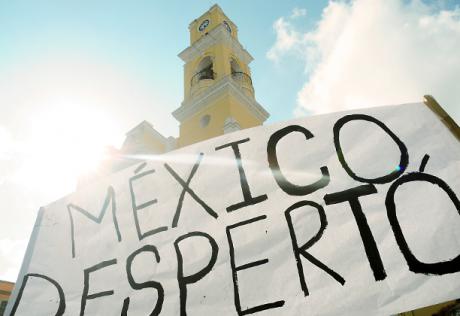
Some rights reserved.
Jose Angel Garcia V. is an Associate Tutor at the Politics Department of the University of Sheffield and the Director of the New Politics Institute. He has a special research interest in public security policy and democratisation processes.
“A government on its knees”: that is how Gil Ramos describes Mexico’s current administration. With an average of nearly 100 homicides per day, seven journalists killed in eight months, an epidemic of disappearances of social activists, students, and civilians, and hundreds of human right violations, it is difficult to counter this statement. In fact, as Bunker and Sullivan have asserted, Mexico’s current situation may fit the definition of a failed state. Contrary to the “Mexican moment” envisaged by Times magazine a year ago, Mexicans are living in an increasingly insecure environment, witnessing noticeable corruption of public institutions, and experiencing ‘ungovernability’ in numerous municipalities. Thus, far from the democratic dream of progress, citizens in Mexico are immersed in a dangerous and still-fragile democracy.
Beginning with the execution of 22 people in Tlatlaya, the past twelve months have been flooded with cases of human rights violations that have shaken Mexican society. Importantly, the extrajudicial killing of a number of unarmed criminals in June 2014 demonstrated that the army was not carrying out its operations with any strict sense of respect for human rights. Despite the Minister of the Interior’s promise to “prosecute this crime to the very end,” the atrocity proved to be only a symptom of the disease affecting the Mexican government and society.
Human rights violations in Mexico, an eye opener
Just three months after the massacre in Tlatlaya, the international community was shocked by the news of the kidnapping of 43 students in Ayotzinapa, in the state of Guerrero. In this case, on the night of September 26th 2014, students from a rural teaching college were attacked by the municipal police of Iguala upon the orders of the town mayor. Three students were killed that night, and forty-three were abducted and handed over to the rouge organisation “Guerreros Unidos” (United Warriors). Worldwide attention and condemnation of the event, and the evident collusion between criminals and government officials forced Mexico’s federal government to request international assistance with the investigation. It was then, when international forensic teams identified DNA fragments of one of the kidnapped students at a municipal dump, that government closed the case and pronounced the students dead in January 2015. However, it is due to the increasing distrust of the country’s judiciary system that this conclusion continues to be rejected by relatives and by the wider society who, far from living in the just and democratic environment of which senior government officials talk, experience injustice on a daily basis.
Regrettably atrocities like Ayotzinapa and Tlatlaya have stopped being the exception, and have instead become an emblem of Mexico’s dangerous and fragile democracy. Two events perfectly evidence this unfortunate condition. First, the violent murder of reporter Ruben Espinosa and social activist Nadia Vera on August 31st this year in Mexico City, a place considered to be one of the most liberal and open metropoles of the Americas. Although some rushed to support the hypothesis of robbery whilst almost considering stupid any other line of inquiry, both Espinosa and Vera had previously blamed the Governor of Veracruz for anything that might have happened, raising important doubts within society. Adding insult to injury, just ten days after Espinosa and Vera’s murder, Miguel Angel Jimenez, a social activist who led search parties looking for the remaining “missing” students of Iguala, was shot dead in his taxi.
These cases not only reflect the ineffectiveness of Mexico’s judicial system, but also remind us of the importance and fragility of democratic values and human rights, including freedom of the press, freedom of association and, above all, the right to life. The promise made by President Peña Nieto to “deliver both the progress Mexicans need and deserve and the socio-political model in which pragmatism and respect of liberal values coexist” seems to be more distant than ever in light of these cases. Rather than being an example for other countries to follow, Mexico is an eye-opener to the fragility of new and corrupt democracies. Domestically, this new ‘democracy’ is clearly causing disillusion within society, as 57% of Mexicans are dissatisfied with the direction of the country—a statistic that should not surprise us as criminality has augmented in certain parts of the country. For instance, the kidnapping rate in places like Tamaulipas has reached the alarming figure of 40 per 100,000 inhabitants. More worrying is that and only 3% of those incidents are met with a sentence. Internationally, Mexico has become an example of a country where the rule of law continues to be disregarded as, in the words of Freedom House, civil and political rights in Mexico continue to be systematically violated. Indeed, this is why the organisation Fund for Peace International has placed a “warning of failure” on the country.
What’s next in Mexico’s democracy?
“Democracy, Dussel says, cannot be justified if it does not secure life.” Paradoxically, the events described above demonstrate how some municipalities, states, and national authorities in Mexico seem to be determined to challenge this assertion. In this vein, Perez is right when saying, “problems will not be solved on their own.” This is why society needs to awaken, become more politically engaged and demand more accountability and responsiveness from the state; otherwise it is likely to remain trapped between criminal organisations and the threat of failure. A participative democracy, many would say, is the way to strengthen the legitimacy of government institutions and, thus, provide a suitable path to address many of the problems of the state. Marching, voting, and shouting—as my colleagues in Sheffield and LSE have done—are some ways to ensure that Tlatlaya or Ayotzinapa do not happen again. However, change will not be immediate, and democracy is a continually evolving process.
Just two decades ago, voting was pointless in “Mexico’s perfect dictatorship.” It took several years, lots of money, and many lives to achieve an electoral democracy where voting does change a government, does change politics, and can change the country. Next year, citizens will elect a governor in Veracruz—the riskiest place for journalists in Mexico—as well as in Oaxaca, Tamaulipas, and Sinaloa, three of the most violent states in Mexico. As in any other democratic election, these ones will evidence society’s level of political interest in local and national problems.
More importantly, in the middle of the states’ violent situation, these democratic exercises represent a social tool for change by giving citizens the right, and perhaps even the obligation, to vote against those politicians, political parties and practices that contravene society’s interests and demands. The upcoming elections might not be the immediate solution to the states’ problems, but they are one of the mechanisms by which citizens, and not only the government, can start making their own “dreams of progress” a reality.



